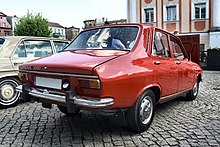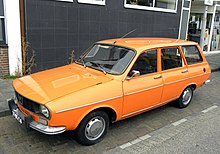Dacia 1300
| Dacia | |
|---|---|
|
Dacia 1300 (1969-1982)
|
|
| 1300 | |
| Production period: | 1969-1982 |
| Class : | Middle class |
| Body versions : | Limousine , station wagon , pick-up , panel van |
| Engines: |
Petrol engines : 1.3 liters (39.7 kW) |
| Length: | 4340 mm |
| Width: | 1636 mm |
| Height: | 1434 mm |
| Wheelbase : | 2441 mm |
| Empty weight : | 900 kg |
| Previous model | Dacia 1100 |
| successor | Dacia 1310 |
The Dacia 1300 , a license for the Renault 12 , is a passenger car from Automobile Dacia . It was produced from August 1969 to 1982. Series production began a little earlier than that of the Renault 12. The Renault 12 was designed as a world car , and the Ford Corcel with its platform was also built in Brazil with a slightly different body.
Unlike its predecessor, the Dacia 1300 was also exported from Romania. In the GDR, the Dacia 1300 was a popular vehicle despite its poor build quality and susceptibility to rust. In 1973 it cost 23,450 M in the GDR . The price hardly differed from that of the Schiguli or the Polski Fiat 125p . From 1979 there was the successor Dacia 1310.
Models
- 1300 (sedan)
- 1300 L (sedan, Lux)
- 1300 LS (Limousine, Lux Super)
- 1300 Break (station wagon)
- 1300 C (pick-up)
- 1300 F (delivery truck)
- 1300 S (ambulance)
Source:
technology
The Dacia 1300 is a vehicle that was built with different body styles, including a sedan, station wagon and pickup truck. It has a self-supporting body with four doors, an engine installed lengthways in front of the front axle and front-wheel drive .
body
The body essentially consists of two components: the floor pan and the vehicle body built on it. The floor assembly has a half frame at the front and rear to accommodate the engine and rear axle. The vehicle body, welded together from several metal sheets, also includes the rear fenders and is welded to the floor pan. He picks up the front fenders, the front-hinged bonnet, trunk lid and doors. The overhang at the front is 859 mm, at the rear 1040 mm. The tank is installed behind the rear axle under the trunk and holds 50 liters. The spare wheel is on the side of the trunk. Some attachments are chrome-plated.
landing gear
The front wheels are individually suspended on double wishbones and are guided at the bottom on triangular wishbones and at the top on simple wishbones and a tension strut. There is a spring / damper unit on the upper link and an anti-roll bar is also installed. The rigid rear axle is guided on a trailing arm each on the left and right and in the middle at the top on a triangular arm installed lengthways. The springs and dampers are concentric on the axle beam, which is welded from sheet metal, and a stabilizer is also installed here. The Dacia 1300 has rack and pinion steering. The tire format is 155 SR × 13.
The braking system depends on the body shape. The sedan has a single-circuit braking system with a brake booster, while the station wagon has a dual-circuit braking system with a brake booster and brake pressure compensation. Both systems have simple disc brakes on the front wheels and brake drums on the rear wheels. The parking brake acts with a cable pull on the brake drums of the rear wheels and is operated with a lever under the dashboard in vehicles of earlier years of construction; however, newer cars have a handbrake lever next to the driver's seat.
engine
The Dacia 1300 is powered by a liquid-cooled inline four-cylinder four-stroke engine with an underneath camshaft and 1.3 liter displacement, which works according to the Otto process . The engine block is made of gray cast iron and the cylinder head is made of aluminum. The engine has a five-bearing crankshaft with four counterweights, the pistons have two compression rings and an oil control ring. The four-bearing camshaft is built into the side of the cylinder block and is driven by a roller chain from the crankshaft, which runs in a timing case on the front of the engine. It operates an intake and an exhaust valve for each cylinder via tappets , bumpers and rocker arms . The intake pipe and exhaust are on one side of the cylinder head . The rocker arm shaft with the rocker arms mounted on it sits under the cylinder head cover. The fuel-air mixture is prepared by a downdraft carburetor, the standard is a Solex 32 EISA 2, but in some cases there are also Solex 32 EISA 3, Carfil 32 IRM-Weber or Carfil 32 IRMA.
Power transmission
The drive power is transmitted from the engine to a four-speed gearbox installed lengthways via a dry single-plate clutch. The rear of the gearbox is suspended from the body, the gearbox output shaft is installed under the gearbox input shaft in the longitudinal direction of the vehicle and transmits power to the differential gear, which is built into the gearbox housing behind the clutch bell underneath the gearbox input shaft. The drive shafts are connected to the front axle differential across the transmission direction and transmit the power to the front wheels.
Technical specifications
| Parameters | 1300 (sedan) |
|---|---|
| Construction year | 1969-1979 |
| Vehicle mass | 900 kg |
| Maximum permissible total mass | 1320 kg |
| Maximum permissible axle load, rear axle | 695 kg |
| Maximum permissible trailer weight, braked | 800 kg |
| Maximum permissible trailer mass, unbraked | 400 kg |
| Maximum permissible trailer mass (vehicle + trailer) | 2080 kg |
| length | 4340 mm |
| width | 1636 mm |
| height | 1434 mm |
| wheelbase | 2441 mm |
| Gauge | 1312 mm |
| tires | 155 SR × 13 (145 SR × 13) |
| Engine type | Water-cooled inline four-cylinder |
| Valve control | OHV |
| Mixture preparation | Downdraft carburetor, type Solex 32 EISA 2 |
| Displacement | 1289 cm 3 |
| Bore × stroke | 73 mm × 77 mm |
| Compression ratio | 1: 8.5 |
| Nominal power (DIN 70020-6) | 39.7 kW (54 hp) at 5250 min -1 |
| Max. Torque (DIN 70020-6) | 94 N m (9.6 m kp) |
| Top speed | 140 km / h |
| Acceleration, 0-100 km / h | 16.5 s |
| Fuel consumption at constant x km / h in. L 100 km | 80 ... 90 km / h: 7.5 ... 8 l 105 km / h: 9 l 115 km / h: 10 l 140 km / h: 13 l |
| transmission | Four-speed gearbox with synchronization in the forward gears |
| Gear ratios | I: 1: 3.615 II: 1: 2.263 III: 1: 1.480 IV: 1: 1.032 R: 1: 3.076 |
| Final drive | 1: 3.770 |
| source |
Individual evidence
- Frank György, Hüttl Pál: Hogyan Tovább? - Dacia 1300. 2nd edition. Müszaki Könyvkiadó, Budapest 1986, ISBN 963-10-4240-5 .
- Werner Oswald: Motor vehicles of the GDR , 2nd edition. Motorbuchverlag, Stuttgart, 2000, ISBN 3-613-01913-2 .
- Online references
- ↑ Csikós Szolt: Világméretű Dacia kultusz? Autócsírák: Renault 12, Dacia… meg ami még , in totalcar.hu, January 18, 2018, accessed on September 28, 2018




